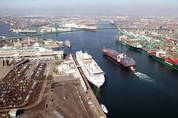
With the presence of ever larger mega-ships and rising container volumes, US West Coast ports are being challenged to adopt a higher level of operational practice and invest in automated technology in order to keep pace with the supply chain.The Journal of Commerce reports Vice President of port planning firm Moffat and Nichol as stating: “San Pedro Bay terminals in their current operating mode are approaching their limits of capacity and service.“The current preferred operating mode cannot meet the challenges of the next phase, in my opinion, and significant change in terminal operation is re
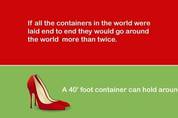
1. There are currently over 17 million shipping containers in circulation globally with the number of active shipping containers at more then five million. In total, they make around 200 million trips a year, according to Billie Box.2. The first metal shipping container was invented by Malcolm McLean in 1956 in order to replace the old style of break-bulk container handling.3. Approximately 97% of all shipping containers are manufactured in China. This is due to a lower labour rate in the country and that much of the world’s products are produced in China.4. According to Grand View Container T
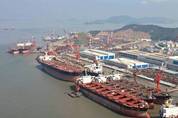
Dry bulk shipping is expected to continue its recovery, thanks to declining excess capacity, increasing iron ore shipments and rising grain trade, according to the latest edition of the Dry Bulk Forecaster, published by shipping consultancy Drewry.The dry bulk market rebounded in the third quarter thanks to the encouraging performance of the Capesize segment, which thrived on strong demand for iron ore from China and high production in Brazil. China’s hunger for imported ore led to a 25% increase in the Baltic Dry Index during the third quarter.However, the Ebola virus outbreak has reduced the
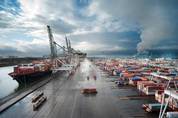
Mainlane container trade volumes are expected to grow by 8% on the peak leg Far East-Europe route and by 6% on the peak leg Transpacific route in full year 2014. Following a period of weaker growth these trades have shown strength since the second half of 2013 and in the year to date they have made an important contribution to global container trade which is now expected to grow by 6.1% in 2014.Rise And FallThe early to mid 2000s were prime years for the mainlanes with total trade growth across these routes regularly exceeding 10% y-o-y, amid a booming world economy and high levels of outsourc
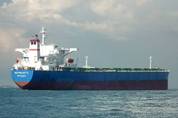
Each year, in the first week of November, we invite readers of the Shipping Intelligence Weekly to predict the value of the ClarkSea Index one year ahead. The competition entries are always interesting, and give us an idea of what the shipping industry’s expectations of the market really are. However, as everyone knows, it’s hard to get it right and the competition can only have one winner…Stick Or TwistIn 2013, it felt like there was some consensus amongst industry players that the bottom of the cycle might have been reached and that markets would start to take a turn for the better. Shipowne
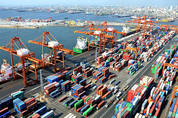
With fears of a union shutdown of US west coast ports intensifying already serious trucking and labour shortages and causing delays at some terminals of up to three weeks, it is easy to forget that supply chain managers on the transpacific trades are also beset by port congestion issues in Asia.Forwarders and shipping lines contacted by Ti report delays of variable lengths at terminals at Incheon, Korea, while Shanghai and Qingdao in China have also suffered recently from congestion. In Vietnam, efforts to divert cargo to vacant terminals Cai Mep and expand draft and berthing capacity at Ho Ch
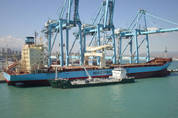
Helping HandThe reduction in vessel productivity resulting from slow steaming in the face of increased fuel costs was initially focussed on the long-haul east-west trades, where slow steaming is operationally more straightforward. However, it has since spread to other parts of the liner network. As box shipping faced up to oversupply in the wake of the economic downturn in 2008, this spread has helpfully absorbed some of the surplus vessel capacity.However, it’s not always simple to quantify the precise amount of capacity absorbed by the drop in vessel productivity. It hasn’t all been due to s

Despite moderate volume growth rates in recent years, the Latin American container trade with the Northern Hemisphere remains the largest of the North-South trades. In May, Container Commentary looked at vessel upsizing on the African North-South trades, and an upsizing trend has also been clear on the Latin American trade lanes where larger ships are providing a rising share of capacity.Volume Growth DriverIn the 2000s prior to the economic downturn, container trade between the Northern Hemisphere (North America, Europe and the Far East) and Latin America rose steadily, from 7.4m TEU in 2002

Very encouraging projections about global air cargo/air freight projected volumes reaches us from the very important forecast by the International Air Transport Association. IATA’s data is one of the finest sets of indicators within the industry and these four year projections released in the last week are a signal that the global recovery for air freight is in full swing.According to the analysis, growth of 4.1% annually should be seen through until 2018, numbers that would far exceed what has been experienced during the last three year. As ever there is a caveat to such a robust forecast wit
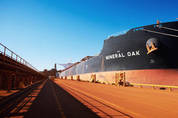
Eleven years ago in 2003, when China opened its doors and the steel boom got underway, the shipping community was suddenly presented with an Aladdin’s Cave of cargo. Unlike Japan and Korea, China had not locked in the fleet of ships it would need. So the escalating imports of iron ore soon turned into a gold mine for shipping. With so much cargo and a limited fleet of ships, Capesize rates surged.Unexpected RichesShipping has always done well out of miracle economies, but the Chinese growth surge which followed was special. In the next decade, Chinese industry, especially steelmaking, grew fas